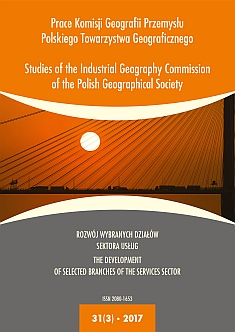Three-sector Division of the European Economy in the Perception of the Inhabitants
DOI:
https://doi.org/10.24917/20801653.313.16Keywords:
agriculture, Europe, industry, perception, servicesAbstract
The research objective of the article was to answer the question of the perceiving of economic sectors with the European countries. Survey-based research, conducted in 2005-2016, covered about 1000 respondents from 7 European countries. The differentiation of perceptions were analyzed on two levels: spatial (7 cities in 7 countries) and time (2005-2007 compared to 2016). It was established that industry and services are associated with the largest European economies, while agriculture is most often associated with the country of origin of the respondent. Research has shown the impact of spatial stereotypes on the perception of industry and the importance of agro-landscape on the perception of agriculture. It has been established in the paper that the perceptions of the economic sectors relate much more to “Western-Centrism” than to their importance in European economies. There were no significant changes in the perception of the sectoral division of the economy between 2005 and 2016.Downloads
Metrics
References
Bank Światowy (2017, 10 lutego). Pozyskano z http://data.worldbank.org/
Bandt, J.D. (1999). The concept of labour and competence requirements in a service economy. Service Industries Journal, 19(1), 1–17.
Cuc, M., Ruggiero, E. (2006). Migration and Remittances in Moldova. International Monetary Fund.
Fourastié, J. (1954). Die große Hoffnung des zwanzigsten Jahrhunderts. Köln: Bund-Verlag.
Gobster, P.H., Nassauer, J.I., Daniel, T.C., Fry, G. (2007). The shared landscape: what does aesthetics have to do with ecology? Landscape Ecology, 22(7), 959–972.
Hönekopp, E. (1997). Labour migration to Germany from Central and Eastern Europe: old and new trends (No. 23). Institut für Arbeitsmarkt-und Berufsforschung der Bundesanstalt für Arbeit. ISTAT (Istituto Nazionale di Statistica) (2017, 10 lutego). Pozyskano z http://www.istat.it
Olins, W. (2002). Branding the nation—The historical context. Journal of Brand Management, 9(4), 241–248. Organizacja Narodów Zjednoczonych do spraw Wyżywienia i Rolnictwa (2017, 10 lutego). Pozyskano z http://www.fao.org/
Padło, T. (2013). Postrzeganie Europy przez młodzież w wybranych krajach europejskich. Kraków: Uniwersytet Jagielloński, praca doktorska.
Padło, T. (2015). Białe plamy w sercu Europy. Kraków: Międzynarodowe Centrum Kultury.
Simon, P. (2003). France and the unknown second generation: preliminary results on social mobility. International Migration Review, 37(4), 1091–1119.
Downloads
Published
How to Cite
Issue
Section
License
Articles are published under the terms of the Creative Commons License (CC BY-ND 4.0; Attribution– NoDerivs).

